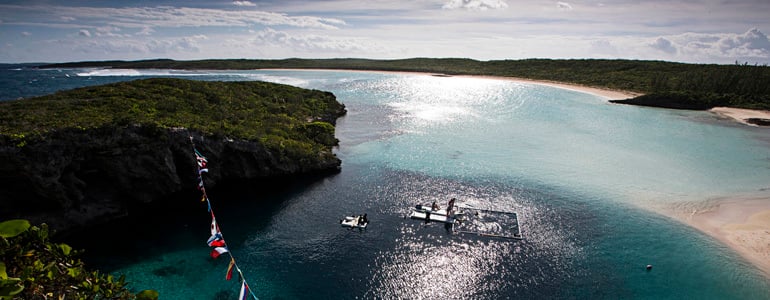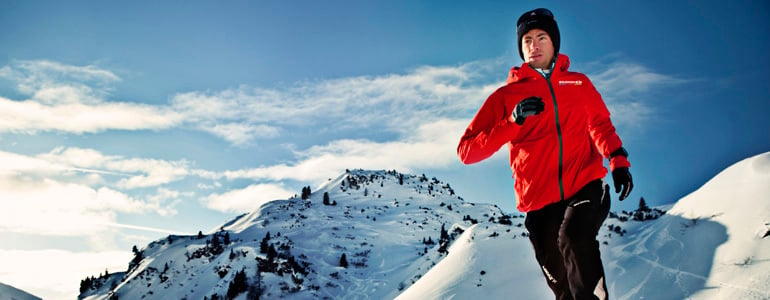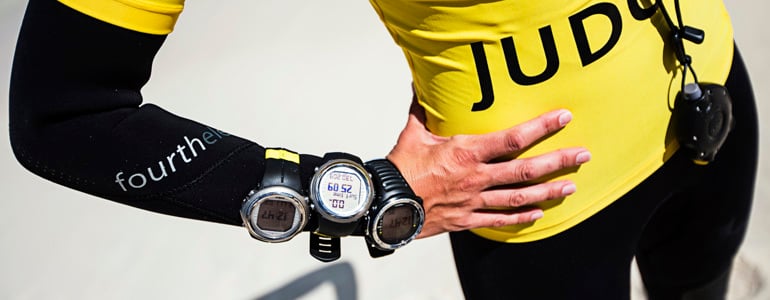

Suunto Blog

Final video from 2014 Suunto Vertical Blue
It's the final clip from the Suunto Vertical Blue freediving contest and goes some way to explaining why the event is the must-attend freediving event in the world. “These are all friends, we're a big family,” says Austria's Jakob Galbavy. “Everyone has a great attitude.”Not only is there great vibe, but Suunto Vertical Blue is home to some incredible performances. “The average depth was in mid 70s including male and female and across all disciplines,“ says organizer Will Trubridge. “It's really a great event for top freedivers.”Don't believe us? Just sit back and enjoy the video below.
Main image: ©Daan Verhoeven

Suunto Vertical Blue: Day 6
Suunto Vertical Blue has now come to an end. It's been an incredible nine days of freediving action with some world class performances from many athletes from around the world. But it hasn't all been about depth records. In this clip, competitors come together for a a day of alternative games that include underwater somersaults, bubble rings and an 'ironfish' contest in which divers jumped off a cliff before swimming underwater to the center of Dean's Blue Hole and then diving to 20 m.
The full report will come soon. But in the meantime, enjoy the clip below.

7 winter trail running tips
Dark mornings, icy roads, gusting winds and sub-zero temperatures ... running during the cold winter months can be a real challenge, sapping our motivation to get outdoors. But winter also can be an advantage, since it forces us to change our training patterns. So don’t get lazy just because it’s cold outside. Here’s how to stay motivated to train outdoors through the winter...
Follow Kilian's example:
Don't run! The world's top trail runner does not run over winter. “I spend half the year running and half the year skiing,” he says. “I don't run in winter. It's good to make a break and try other sports. If you live where there's snow, it's better to go cross-country skiing or ski mountaineering. Running in the snow can be good,” he adds “but you need to take care because the muscles work differently and you can pick up injuries.”
Gear up
There's no such thing as bad weather – just the wrong clothing, so goes the adage. Since your feet are the most important, it makes sense to look after them. Gore-tex lined running shoes are ideal for snow and wet conditions. When there's snow and ice, wear shoes with spikes.
Work on your style
No, we don't mean which gilet to wear – your running style. If you're running at night and on trails, speed work is out of the question. So it's a chance to slow-up and concentrate on your technique and work on your form so you're more efficient and less injury prone.
Don't overdress
It's temping to put on all the layers before heading out the door but even in the coldest conditions your body will still warm up and there's nothing worse than over-heating in the cold as that dampness will chill you the moment you stop. Head out the door a little cold and start off easily so you warm up gradually. Consider taking a running rucksack to carry an extra layer and survival extras like phone and energy food.
Track Back
With your Suunto watch you never need to worry about getting lost and failing to make it back home. If you lose your way in the dark, simply hit Find Back on your Suunto 9 and let your watch show you the way home.
Run to time rather than distance
Plan a time-based training program, meaning that workouts are prescribed in minutes rather than kilometers. This recognizes the variability of running conditions due to weather. When it's cold and slippery, it's hard to maintain the same fast pace you might in the spring or fall.
Go inside
Indoors isn't so bad and a bit of training at the gym can really improve your running fitness and overall strength. Think about signing up to a core-strength building class like Pilates or circuit training.
Lead image: © zooom.at/bergermarkus.com

3 days to enter #paradise contest
Crystal clear waters, incredible sealife, unspoilt beaches and untapped diving sites. And did we mention the pure luxury that only Ayada Maldives can offer? You could be enjoying all this and more next month but only if you send us your most memorable diving moment.
There are just three days left before the contest closes. Already we have been inundated with your submissions – over 1,000 received so far. But we want to see more. Check out the collage below for some inspiration and then click here for all the details on how to enter.
The contest closes at 9am CET, Monday 8th December. We look forward to seeing your entry!

Vertical Blue: Day 5 highlights clip
Here's another take on a dramatic day 5 at the Suunto Vertical Blue. Although the main focus of the day was the world record attempt of Will Trubridge, this clip shines the spotlight on some of the other athletic performances at Dean's Blue Hole.

Win an exclusive diving trip with the Suunto team and the Scuba Diver Girls to the luxurious Ayada Maldives
Share your most memorable diving moment and dive with the Scuba Diver Girls in the Maldives.
Want to win an all-expenses paid VIP trip to one of the world's best dive sites? Now's your chance! The Suunto team is organizing a photo shoot and is heading to the luxurious Ayada Maldives with the Scuba Diver Girls, in January 2015 and we'd like you to join us.
All you have to do is share your most memorable diving moment with us. So long as it captures the joy of diving, it could take you one step closer to the dream trip.
© Janice Carter
Plunge in and win
Your ticket to paradise could be an inspiring image or video that captures your favorite diving moment. There are three ways to participate:
Post and tag your image or video #SuuntoDive and #Paradise on Instagram or Twitter
Upload an image or a link to your video as a comment on the official contest announcement on Facebook, click here.
Or complete this form and hit submit.
© Ayada Maldives
Relax above, explore below
Your entry could take you to Ayada Maldives, a luxurious 5-star retreat located in the Southern Atolls. The private island, which is ringed by a pristine coral reef popular with dolphins, offers 112 spacious villas and suites, all with private pools and thoughtful five-star detailing. More info: www.ayadamaldives.com
Test Suunto dive computers
You'll also have the chance to test a range of Suunto dive computers, and with the Suunto team on hand you'll receive an expert demonstration from the people who made the products.
Let the Scuba Diver Girls guide you through an underwater world that is rich in species and explore some reefs that have rarely, if ever, been dived before. We look forward to seeing your special diving moment! The Scuba Diver Girls will select the three best entries.
The contest opens on November 19th and closes on December 8th. The three winners will be announced mid December on Suunto.com. The trip to the Maldives is scheduled for January 10th-17th, 2015, so be sure to save the date!
Read more on the terms & conditions here.














































































